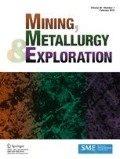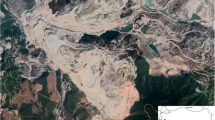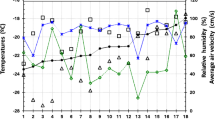Abstract
Excessive heat exposure is among the health and safety hazards that have adverse effects on the mine workers. The very nature of the underground climate makes it a convenient avenue for heat generation and accumulation from several heat sources including autocompression, equipment, and heat from strata. This study investigated the effects of clothing insulation and acclimation on the thermal comfort of mine workers who are exposed to heat in underground working environments. Several clothing ensembles have been considered to analyze the effect of the thermal resistance of clothing on the thermal comfort of workers. To investigate the impact of the clothing insulation, the thermal comfort limit of an underground miner was calculated in the form of maximum allowable exposure time for an 8-h shift. Parametric analyses were subsequently performed using an already developed thermal comfort model using MATLAB software. The results demonstrate that clothing insulation has a significant effect on the thermal comfort of mine workers. Increase in the clothing insulation decreases the maximum allowable exposure time of mine workers. This is especially true for the new and non-acclimated workers. Since acclimatized workers can tolerate a higher level of the dehydration and are capable of losing more water by sweat per shift, the maximum allowable exposure time for the acclimated workers are higher than non-acclimated workers. These analyses have shown that acclimated workers can have more continuous work per shift compared with non-acclimated workers. For example, in an environmental condition with clothing that a non-acclimated worker cannot work more than 5 h, an acclimated worker can work a full 8-h shift.






Similar content being viewed by others
References
Roghanchi P, Kocsis KC (2018) Challenges in selecting an appropriate heat stress index to protect workers in hot and humid underground mines. Saf Health Work 9(1):10–16
Roghanchi P (2017) Managing and controlling the thermal environment in underground metal mines. Doctoral Dissertation, University of Nevada, Reno
Hanna EG, Kjellstrom T, Bennett C, Dear K (2011) Climate change and rising heat: population health implications for working people in Australia. Asia Pacific Journal of Public Health 23:14S–26S
Kjellstrom T, Lemke B, Hyatt O, Otto M (2014) Climate change and occupational health: a south African perspective. S Afr Med J 104(8):586
Song X, Wang S, Hu Y, Yue M, Zhang T, Liu Y, Tian J, Shang K (2017) Impact of ambient temperature on morbidity and mortality: an overview of reviews. Sci Total Environ 586:241–254
Maurya T, Karena K, Vardhan H, Aruna M, Raj MG (2015) Potential sources of heat in underground mines–a review. Procedia Earth and Planetary Science 11:463–468
Talebi E, Roghanchi P, Abbasi B (2019) Heat management in mining industry: personal risk factors, mitigation practices, and industry actions. In: 17th North American mine ventilation symposium, Madiseh A, Sasmito A, Hassani F, Stachulak J, eds. Montreal, QC, Canada
Roghanchi P, Kocsis KC, Sunkpal M (2016) Sensitivity analysis of the effect of airflow velocity on the thermal comfort in underground mines. Journal of Sustainable Mining 15(4):175–180. https://doi.org/10.1016/j.jsm.2017.03.005
Webber RCW, Franz RM, Marx WM, Schutte PC (2003) A review of local and international heat stress indices, standards and limits with reference to ultra-deep mining. Journal of the South African Institute of Mining and Metallurgy 103(5):313–324 https://www.saimm.co.za/Journal/v103n05p313.pdf%0, https://hdl.handle.net/10520/AJA0038223X_2862
Jacklitsc B, Williams WJ, Musolin K, Coca A, Kim J, Turner N (2016) Criteria for a recommended standard: occupational exposure to heat and hot environments. National Institute for Occupational Safety and Health (NIOSH). https://www.cdc.gov/niosh/docs/2016-106/pdfs/2016-106.pdf?id=10.26616/NIOSHPUB2016106
Graveling R, Morris L, Graves R (1988) Working in hot conditions in mining: a literature review. Institute of Occupational Medicine, Ergonomic Branch
Sunkpal MN (2015) Assessing thermal comfort in deep underground mines. Dissertation, University of Nevada, Reno. https://scholarworks.unr.edu/bitstream/handle/11714/2651/Sunkpal_unr_0139M_11926.pdf?sequence=1&isAllowed=y
Macpherson RK (1962) The assessment of the thermal environment. A review. Occupational and Environmental Medicine 19(3):151–164. https://doi.org/10.1136/oem.19.3.151
Djongyang N, Tchinda R, Njomo D (2010) Thermal comfort: a review paper. Renew Sust Energ Rev 14(9):2626–2640
Lotens WA (2011) Heat exchange through plastics. Encyclopaedia of Occupational Health and Safety. http://www.iloencyclopaedia.org/part-vi-16255/heat-and-cold/76-42-heat-and-cold/heat-exchange-through-clothing
Song G, Mandal S, Rossi RT (2016) Thermal protective clothing for firefighters. Woodhead Publishing. https://books.google.com/books?hl=en&lr=&id=kXe0CwAAQBAJ&oi=fnd&pg=PP1&dq=Thermal+protective+clothing+for+firefighters&ots=oZFzltanmN&sig=pyK3n5065BFbZprVABrMqt1KdPg#v=onepage&q=Thermal protective clothing for firefighters&f=false
McLellan TM, Pope JI, Cain JB, Cheung SS (1996) Effects of metabolic rate and ambient vapour pressure on heat strain in protective clothing. Eur J Appl Physiol Occup Physiol 74(6):518–527
Givoni B, Goldman RF (1972) Predicting rectal temperature response to work, environment, and clothing. J Appl Physiol 32(6):812–822
Carter BJ, Cammermeyer M (1985) Emergence of real casualties during simulated chemical warfare training under high heat conditions. Mil Med 150(12):657–665
ISO 7243 (1989) Hot environments - estimation of the heat stress on working man, based on the WBGT-index (Wet bulb globe temperature)
Occupational Safety and Health Administration (OSHA) (2017) Heat Stress. https://www.osha.gov/dts/osta/otm/otm_iii/otm_iii_4.html
ASHRAE Handbook-Fundamentals (1997) American society of heating, Refrigerating and Air-Conditioning Engineers
Sunkpal M, Roghanchi P, Kocsis KC (2018) A method to protect mine workers in hot and humid environments. Saf Health Work 9(2):149–158
McPherson MJ (1993) Subsurface ventilation and environmental engineering. Chapman and Hall, London
Fanger PO (1970) Thermal comfort. Analysis and Application in Environment Engineering
Larry K (1970) Encyclopaedia of occupational health and safety. In: Jacques M (ed) The Physical Basis of Work in Heat, 4th edn. Internationational Labour Office, Wellington
Mairiaux P, Malchaire J, Candas V (1987) Prediction of mean skin temperature in warm environments. Eur J Appl Physiol Occup Physiol 56(6):686–692
Wacławik J, Branny M (2004) Nummerical modelling of heat exchange between a human body and the environment. Arch Min Sci 49(2):223–251 https://www.infona.pl/resource/bwmeta1.element.baztech-article-BWA5-0001-0016/tab/summary
Gagge A (1981) Rational temperature indices of thermal comfort. In: Studies in environmental science. Elsevier, Amsterdam, pp 79–98. https://doi.org/10.1016/S0166-1116(08)71082-3
Malchaire J, Kampmann B, Havenith G, Mehnert P, Gebhardt HJ (2000) Criteria for estimating acceptable exposure times in hot working environments: a review. Int Arch Occup Environ Health 73(4):215–220
Wang S, Ren T, Zhang T, Liang Y, Xu Z (2012) Hot environment- estimation of thermal comfort in deep underground mines. In: 12th Coal Operators’ Conference, University of Wollongong. pp 241–9 https://ro.uow.edu.au/cgi/viewcontent.cgi?referer=https://www.google.com/&httpsredir=1&article=2073&context=coal
ISO 7933 (2004) Ergonomics of the thermal environment - analytical determination and interpretation of heat stress using calculation of the predicted heat strain
ISO 7933 (1989) Hot environments - analytical determination and interpretation of thermal stress using calculation of required sweat rate
Department of Industry and Resources (1997) Management and Prevention of Heat Stress. https://www.dmp.wa.gov.au/Documents/Safety/MSH_G_ManagementAndPreventionOfHeatStress.pdf
Leithead C, Lind A (1964) Heat stress and heat disorders. London Cassell
WHO Scientific Group (1969) Health factors involved in working under conditions of heat stress. Geneva. https://apps.who.int/iris/handle/10665/40716
Hancock PA (1982) Task categorization and the limits of human performance in extreme heat. Aviat Space Environ Med
Sawka M, Wenger C, Montain S, Kolka M, Bettencourt B, Flinn S, et al (2003) Heat stress control and heat casualty management. https://www.dir.ca.gov/oshsb/documents/Heat_illness_prevention_tbmed507.pdf
Tian Z, Zhu N, Zheng G, Wei H (2011) Experimental study on physiological and psychological effects of heat acclimatization in extreme hot environments. Build Environ 46(10):2033–2041
Tipton MJ, Pandolf K, Sawka M, Werner J, Tylor N (2008) Physiological responses and adaptations to hot and cold environments. In: Taylor N, Groeller H, McLennan P (eds) Physiological bases of human performance during work and exercise. Churchill Livingstone, London, pp 379–400
Navy Environmental Health Center (2007) Prevention and treatment of heat and cold stress injury. Portsmouth, Virginia. http://www.public.navy.mil/surfor/Documents/6260_6A_NMCPHC_TM.pdf
Lind AR, Bass DE (1963) Optimal exposure time for development of acclimatization to heat. Federation Proceedings, pp 704–708. https://www.ncbi.nlm.nih.gov/pubmed/13930724
Wyndham CH (1973) The physiology of exercise under heat stress. Annu Rev Physiol 35(1):193–220
Arbury S, Jacklitsch B, Farquah O, Hodgson M, Lamson G, Martin H, Profitt A (2014) Heat illness and death among workers—United States, 2012–2013. MMWR. Morbidity and mortality weekly report 63(31):661
Hartman HL, Mutmansky JM, Ramani R, Wang YJ (2012) Mine ventilation and air conditioning, 3rd edn. Wiley, New York https://www.worldcat.org/title/mine-ventilation-and-air-conditioning/oclc/827207860
Piekarski C (1995) Climatic stress in coal mining in Germany: occupational health aspects. Ergonomics 38(1):23–35
Al Sayed C, Vinches L, Hallé S (2016) Towards optimizing a personal cooling garment for hot and humid deep mining conditions. Open J Optim 5(01):35
Author information
Authors and Affiliations
Corresponding author
Ethics declarations
Conflict of Interest
On behalf of all authors, the corresponding author states that there is no conflict of interest.
Additional information
Publisher’s Note
Springer Nature remains neutral with regard to jurisdictional claims in published maps and institutional affiliations.
Rights and permissions
About this article
Cite this article
Talebi, E., Sunkpal, M., Sharizadeh, T. et al. The Effects of Clothing Insulation and Acclimation on the Thermal Comfort of Underground Mine Workers. Mining, Metallurgy & Exploration 37, 1827–1836 (2020). https://doi.org/10.1007/s42461-020-00208-7
Received:
Accepted:
Published:
Issue Date:
DOI: https://doi.org/10.1007/s42461-020-00208-7




